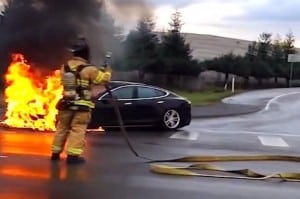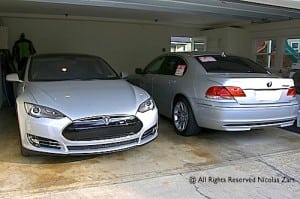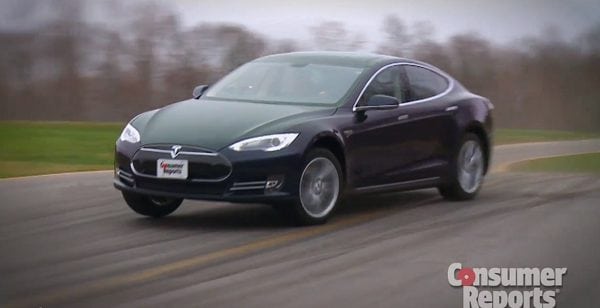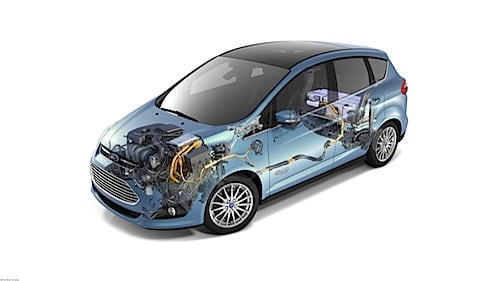
You have to hand it to Tesla Motors. Elon Musk is sometimes brash, out of line, but no other CEO, whose company is worth half of GM, handles a car fire as well as the company did.
Before we post the official Tesla Motors full response about the Model S fire on a Washington state highway on Tuesday, let’s look at the event and how tesla handled the situation.
One Model S Catches on Fire.
In our original story, we asked if one electric car fire should equal a six percent share drop. In this case, what should happen with the 285,000 gasoline and the 5,500 gasoline station car fires each year? You can do the quick math. Most car makers and gasoline station owners would be out of business.
Model S Fire, What Happened?
The Model S ran over a large piece of debris that impaled the Model S. Elon Musk states below that the debris was very big in order to punch a 3 inch diameter hole in the car, with the force of 25 tons. Remember the NHTSA rates the Tesla Motors Model S with 5 stars. Yesterday, fellow writer Aaron Turpen posted the original Elon Musk newsletter sent to everyone on the company’s mailing list.
What is even more interesting in the full response below is that Musk states the facts, as is.

What Carmakers Can Learn From Tesla Motors.
The gist here is what can carmakers learn from how Elon Musk and tesla Motors handled this fire situation. Elon and Tesla Motors understand how rabid mainstream news is when it comes to electric cars (EV). A swift response is needed in order to nip it in the bud. However, Musk and Tesla waited to have all information in hand before talking. In fact, Tesla handled the Model S’ faulty back seat hinge soldering in a similar manner, quickly.
Last year Nissan ran into battery thermal problems, which led to degradation in capacity and range. Unfortunately, the company stumbled and waited a very long time to address the issue, still not to every owner’s tastes.
Take the bull by the horn! And this is exactly what Tesla Motors did, while waiting for the official facts to come in. Cut to the chase. Wait to have all information, then explain what happened. This fire accident would have been as devastating with a gasoline car, if not worse. Gasoline lines run from the tank to the engine, unprotected, unlike battery cases and cables in EVs. The fact that the fire was contained only to the front section of the Model S, as is apparent from the pictures is a testament to how strong the EV is and the high level of engineering. More so, this Elon Musk response shows how carmakers should handle tricky situations. Wait for the facts, then show it had nothing to do with the car itself, if applicabale.
Congratulations Tesla Motors on a mature move. This is a welcome relief from the incessant hollow PR releases we are flooded with. We hope the automobile community takes notice and starts treating its owners and enthusiasts with such straight forwardness.
Press Release:
About the Model S fire
By Elon Musk, Chairman, Product Architect & CEO
Earlier this week, a Model S traveling at highway speed struck a large metal object, causing significant damage to the vehicle. A curved section that fell off a semi-trailer was recovered from the roadway near where the accident occurred and, according to the road crew that was on the scene, appears to be the culprit. The geometry of the object caused a powerful lever action as it went under the car, punching upward and impaling the Model S with a peak force on the order of 25 tons. Only a force of this magnitude would be strong enough to punch a 3 inch diameter hole through the quarter inch armor plate protecting the base of the vehicle.
The Model S owner was nonetheless able to exit the highway as instructed by the onboard alert system, bring the car to a stop and depart the vehicle without injury. A fire caused by the impact began in the front battery module – the battery pack has a total of 16 modules – but was contained to the front section of the car by internal firewalls within the pack. Vents built into the battery pack directed the flames down towards the road and away from the vehicle.
When the fire department arrived, they observed standard procedure, which was to gain access to the source of the fire by puncturing holes in the top of the battery’s protective metal plate and applying water. For the Model S lithium-ion battery, it was correct to apply water (vs. dry chemical extinguisher), but not to puncture the metal firewall, as the newly created holes allowed the flames to then vent upwards into the front trunk section of the Model S. Nonetheless, a combination of water followed by dry chemical extinguisher quickly brought the fire to an end.
It is important to note that the fire in the battery was contained to a small section near the front by the internal firewalls built into the pack structure. At no point did fire enter the passenger compartment.
Had a conventional gasoline car encountered the same object on the highway, the result could have been far worse. A typical gasoline car only has a thin metal sheet protecting the underbody, leaving it vulnerable to destruction of the fuel supply lines or fuel tank, which causes a pool of gasoline to form and often burn the entire car to the ground. In contrast, the combustion energy of our battery pack is only about 10% of the energy contained in a gasoline tank and is divided into 16 modules with firewalls in between. As a consequence, the effective combustion potential is only about 1% that of the fuel in a comparable gasoline sedan.
The nationwide driving statistics make this very clear: there are 150,000 car fires per year according to the National Fire Protection Association, and Americans drive about 3 trillion miles per year according to the Department of Transportation. That equates to 1 vehicle fire for every 20 million miles driven, compared to 1 fire in over 100 million miles for Tesla. This means you are 5 times more likely to experience a fire in a conventional gasoline car than a Tesla!
For consumers concerned about fire risk, there should be absolutely zero doubt that it is safer to power a car with a battery than a large tank of highly flammable liquid.
— Elon
Below is [Tesla Motors’] email correspondence with the Model S owner that experienced the fire, reprinted with his permission:
From: robert Carlson
Sent: Thursday, October 03, 2013 12:53 PM
To: Jerome Guillen
Subject: carlson 0389
Mr. Guillen,
Thanks for the support. I completely agree with the assessment to date. I guess you can test for everything, but some other celestial bullet comes along and challenges your design. I agree that the car performed very well under such an extreme test. The batteries went through a controlled burn which the internet images really exaggerates. Anyway, I am still a big fan of your car and look forward to getting back into one. Justin offered a white loaner–thanks. I am also an investor and have to say that the response I am observing is really supportive of the future for electric vehicles. I was thinking this was bound to happen, just not to me. But now it is out there and probably gets a sigh of relief as a test and risk issue-this “doomsday” event has now been tested, and the design and engineering works.
rob carlson
On Oct 3, 2013, at 12:29 PM, Jerome Guillen wrote:
Dear Mr. Carlson:
I am the VP of sales and service for Tesla, reporting directly to Elon Musk, Tesla’s CEO.
I am sorry to hear that you experienced a collision in your Model S 2 days ago. We are happy that the Model S performed in such a way that you were not injured in the accident and that nobody else was hurt.
I believe you have been in contact with Justin Samson, our service manager, since the accident. We are following this case extremely closely and we have sent a team of experts to review your vehicle. All indications are that your Model S drove over large, oddly-shaped metal object which impacted the leading edge of the vehicle’s undercarriage and rotated into the underside of the vehicle (“pole vault” effect). This is a highly uncommon occurrence.
Based on our review thus far, we believe that the Model S performed as designed by limiting the resulting fire to the affected zones only. Given the significant intensity of the impact, which managed to pierce the 1/4 inch bottom plate (something that is extremely hard to do), the Model S energy containment functions operated correctly. In particular, the top cover of the battery provided a strong barrier and there was no apparent propagation of the fire into the cabin. This ensured cabin integrity and occupant safety, which remains our most important goal.
We very much appreciate your support, patience and understanding while we proceed with the investigation. Justin keeps me closely informed. Please feel free to contact me directly, if you have any question or concern.
Best regards,
Jerome Guillen I VP, WW sales and service







